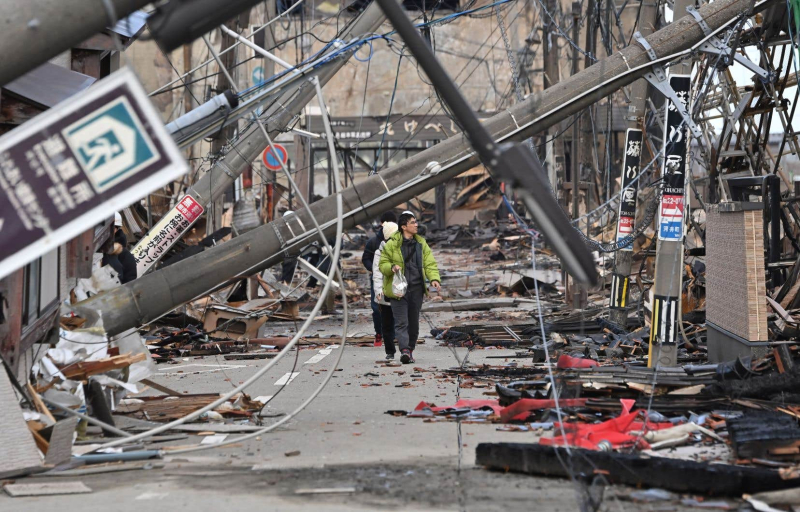
Kazuhiro Nogi Agence France-Presse While the Ishikawa department reports 84 deaths, the toll could rise further because hundreds of buildings were destroyed in the disaster, including a huge fire in the town of Wajima, and villages are still isolated.
The chances of finding survivors are dwindling in central Japan where nearly 200 people are still missing on Thursday, three days after the powerful New Year's earthquake which left 84 dead according to a provisional toll .
The 7.5 magnitude quake, felt as far away as Tokyo, 300 km away, shook the Noto Peninsula in Ishikawa Prefecture, a narrow strip of land that juts out from a hundred kilometers into the Sea of Japan, collapsing buildings and devastating roads.
“This is the most serious catastrophe” of the Reiwa era, which began in 2019 with the accession to the throne of the current Japanese emperor, Prime Minister Fumio Kishida said Thursday during a conference of press.
More than 72 hours have now passed since the disaster, dimming hopes of finding survivors. In this regard, the authorities released the names of 179 people still missing on Thursday.
Once this deadline passes, “the survival rate of people needing to be rescued will drop sharply,” Ishikawa Governor Hiroshi Hase said in the morning.
Also read
- Series of powerful earthquakes in Japan, followed by a tsunami
- “Race against time” to find survivors of an earthquake in Japan
- Rain complicates rescue work in Japan after New Year's earthquake
An octogenarian rescued
In this context, a small miracle occurred: an octogenarian trapped in a ruined house was saved on Wednesday thanks to a rescue dog, the Japanese Minister of Defense announced on Thursday.
She was found by Jennifer, a dog who was one of the animals specially trained for this type of mission and deployed in the regions hardest hit by the earthquake.
These dogs joined the thousands of soldiers and firefighters dispatched from all over Japan for search operations on the coast of the Sea of Japan.
“The Self-Defense Forces [the Japanese army, editor's note] rescued 122 people [Wednesday], including an elderly woman in a house in the town of Wajima, who was rescued by a search dog [Jennifer],” he said. writes Defense Minister Minoru Kihara on the social network X.
“Today, a crucial day, the number [of rescuers] will be increased to around 4,600 people,” he added.
84 deaths
While the Ishikawa department reports 84 deaths, this toll could rise further because hundreds of buildings have been destroyed, notably in a huge fire in Wajima, and villages are still isolated .
“I came to check on members of my family, I haven’t managed to see them yet,” an 80-year-old man told AFP in this city, not wishing to be named.
“It’s terrible, there’s nothing left, […] it’s exactly as if there had been war,” he added.
At least 330 people were also injured by the earthquake and the hundreds of aftershocks that followed, some of which were very strong. A tsunami also hit the coast, with waves more than a meter high sweeping the quays and seaside roads.
According to public broadcaster NHK, a person was swept away by the tidal wave near Suzu, at the tip of the peninsula, and the coast guard was searching for him.
Also according to NHK, a group of researchers estimated that the tsunami hit the town of Suzu less than a minute after the earthquake, leaving little time to evacuate the shore.
Rain further complicated the search and weather services warned of the risk of landslides.
Not enough food
These conditions also made it more difficult to deliver food and equipment to the victims, 300 of whom took refuge in a school in Suzu.
“Even if I give my children my portion of food, it’s still not enough. I have barely eaten anything in the last two days,” a woman in her thirties who lives in this town testified in the daily Asahi.
Several hundred homes are still without electricity in Ishikawa, according to the local electricity company.
Located on the Pacific Ring of Fire, Japan is one of the countries with the most frequent earthquakes.
The Japanese archipelago is haunted by the memory of the terrible 9.0 magnitude earthquake followed by a giant tsunami in March 2011 on its northeastern coasts, a disaster which left some 20,000 dead and missing.
This disaster also led to the Fukushima nuclear accident, the most serious since Chernobyl in 1986.

